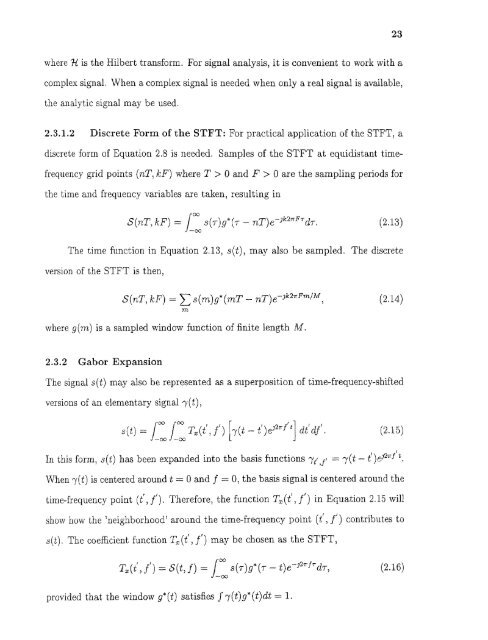Space/time/frequency methods in adaptive radar - New Jersey ...
Space/time/frequency methods in adaptive radar - New Jersey ...
Space/time/frequency methods in adaptive radar - New Jersey ...
You also want an ePaper? Increase the reach of your titles
YUMPU automatically turns print PDFs into web optimized ePapers that Google loves.
23where 9/ is the Hilbert transform. For signal analysis, it is convenient to work with acomplex signal. When a complex signal is needed when only a real signal is available,the analytic signal may be used.2.3.1.2 Discrete Form of the STFT: For practical application of the STFT, adiscrete form of Equation 2.8 is needed. Samples of the STFT at equidistant <strong>time</strong><strong>frequency</strong>grid po<strong>in</strong>ts (nT, lc F) where T > 0 and F > 0 are the sampl<strong>in</strong>g periods forthe <strong>time</strong> and <strong>frequency</strong> variables are taken, result<strong>in</strong>g <strong>in</strong>The <strong>time</strong> function <strong>in</strong> Equation 2.13, s(t), may also be sampled. The discreteversion of the STFT is then,where g (m) is a sampled w<strong>in</strong>dow function of f<strong>in</strong>ite length M.2.3.2 Gabor ExpansionThe signal s(t) may also be represented as a superposition of <strong>time</strong>-<strong>frequency</strong>-shiftedversions of an elementary signal γ(t),In this form, s(t) has been expanded <strong>in</strong>to the basis functionsWhen γ(t) is centered around t 0 and ƒ 0, the basis signal is centered around the<strong>time</strong>-<strong>frequency</strong> po<strong>in</strong>t (t', ƒ`). Therefore, the function Tx (t', ƒ') <strong>in</strong> Equation 2.15 willshow how the 'neighborhood' around the <strong>time</strong>-<strong>frequency</strong> po<strong>in</strong>t (t', ƒ ' ) contributes tos(t). The coefficient function Tx (t' , ƒ') may be chosen as the STFT,provided that the w<strong>in</strong>dow ,
















